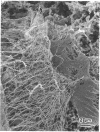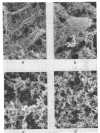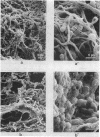Abstract
Interactions between bacterial biofilms formed by Pseudomonas aeruginosa and clarithromycin, a macrolide having no anti-P. aeruginosa activity, were investigated. P. aeruginosa incubated for 10 days on membrane filters formed biofilms on the surfaces of the filters. The biofilms were characterized by dense colonizations of bacteria and thick membranous structures that covered the colonies. Treatment of the biofilms with a relatively low concentration of clarithromycin for 5 days resulted in an eradication of the membranous structures. Quantitative analysis of alginate and hexose was done to evaluate the quantity of polysaccharides in or on the biofilms. Treatment of the biofilms with clarithromycin decreased the quantity of alginate and hexose and therefore perhaps the quantity of polysaccharides as well. Eradication of the membranous structures of biofilms, or the decrease in the quantity of polysaccharides, resulted in an increase in the rate of penetration of antibiotics through bacterial biofilms. In vivo therapeutic effects of ofloxacin in the rat infection model, in which the biofilm mode of growth of P. aeruginosa is characteristic, were enhanced by oral coadministration of clarithromycin. It is suggested that clarithromycin eradicated glycocalyx produced by P. aeruginosa, or suppressed the production of glycocalyx, by unknown mechanisms and thereby enhanced the therapeutic efficacies of other antimicrobial agents against infections caused by P. aeruginosa.
Full text
PDF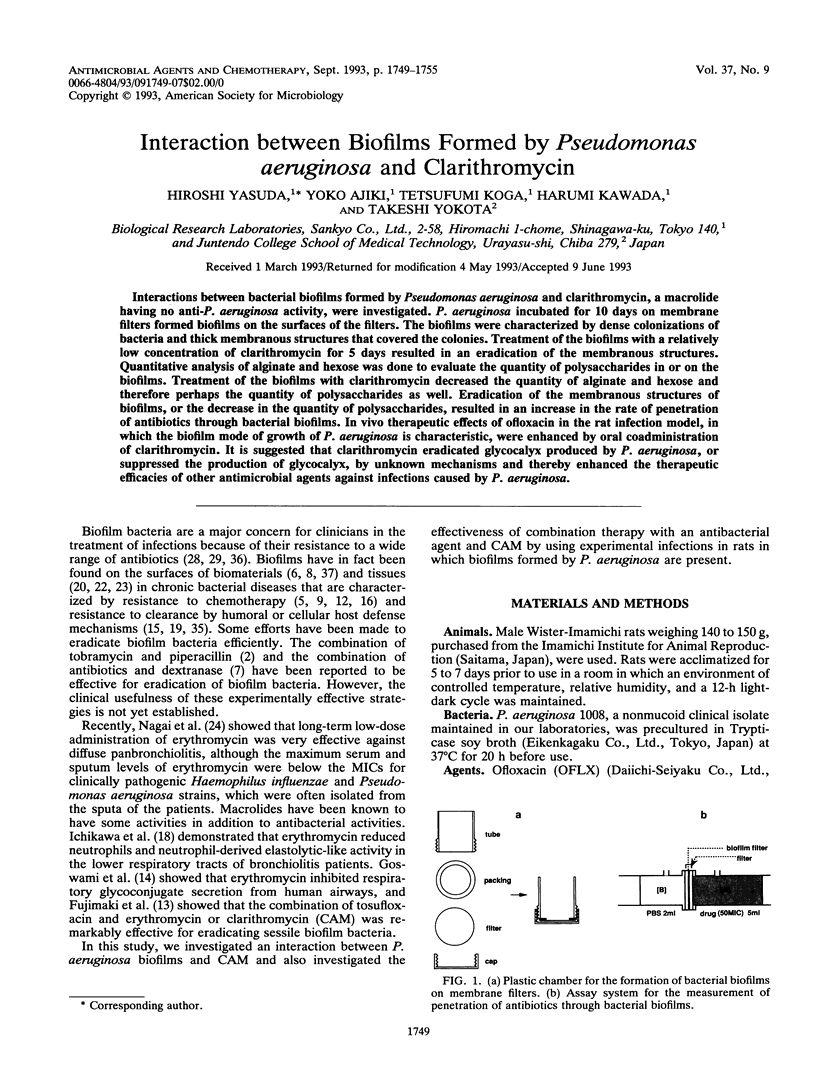
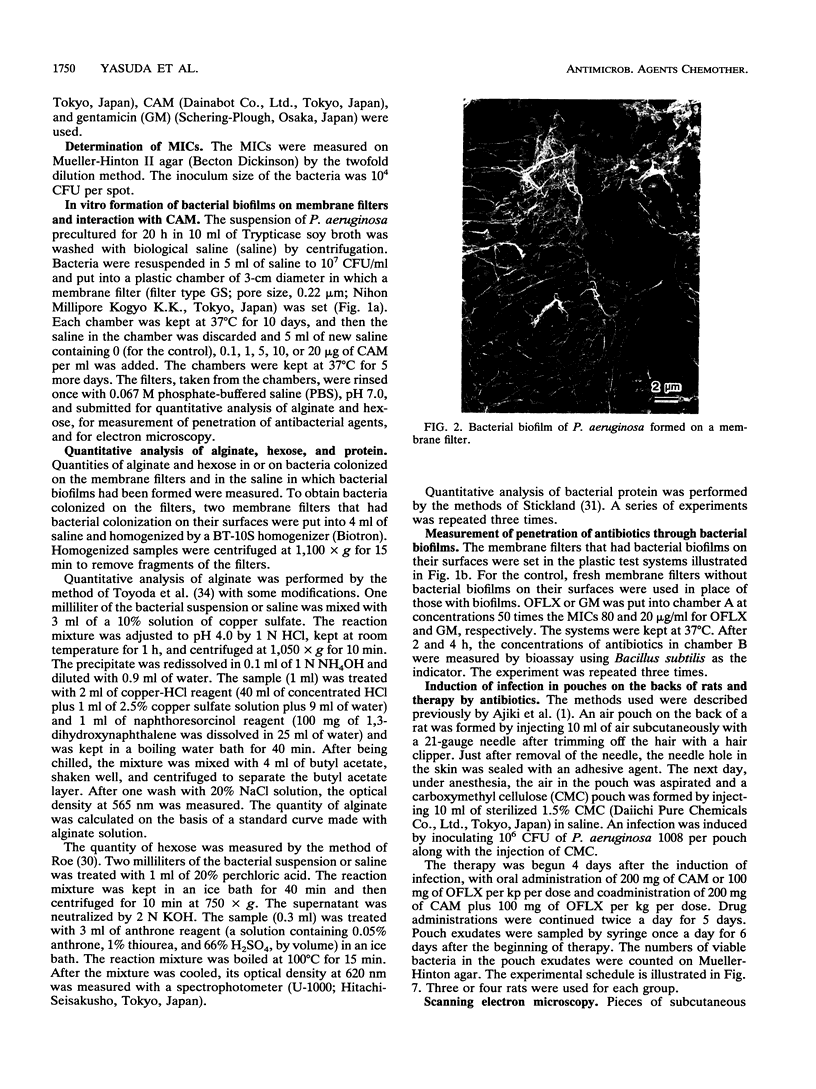

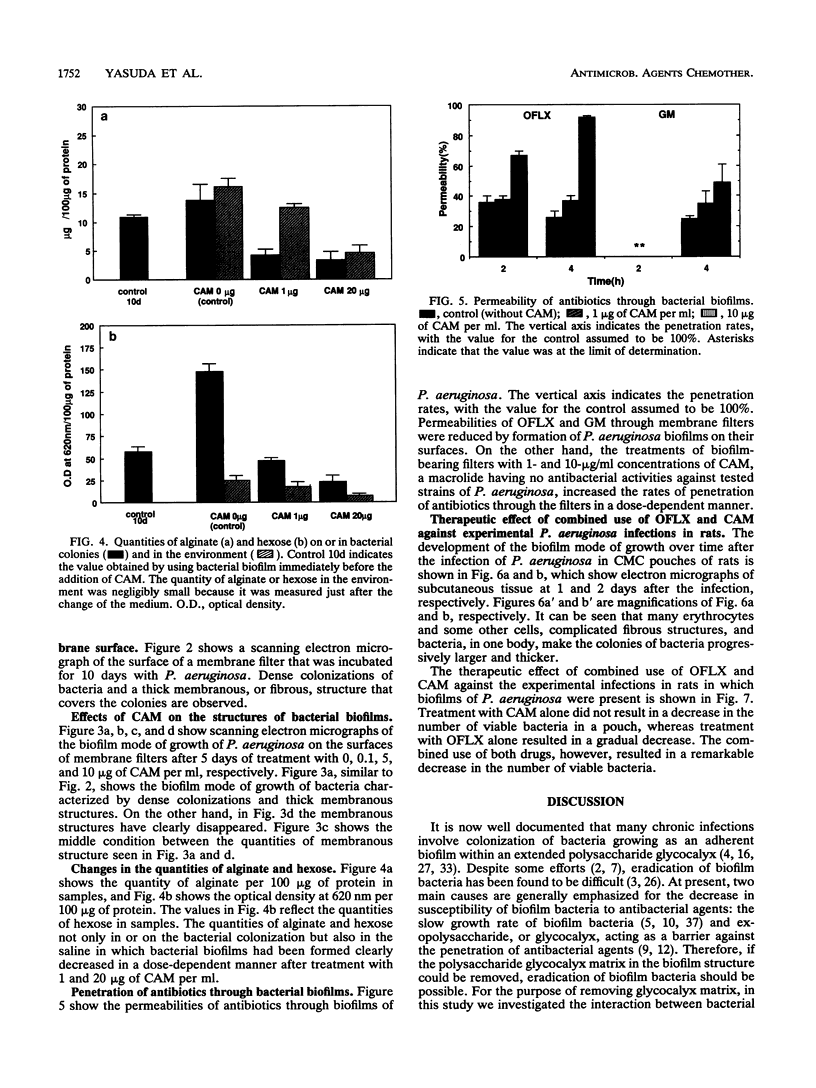
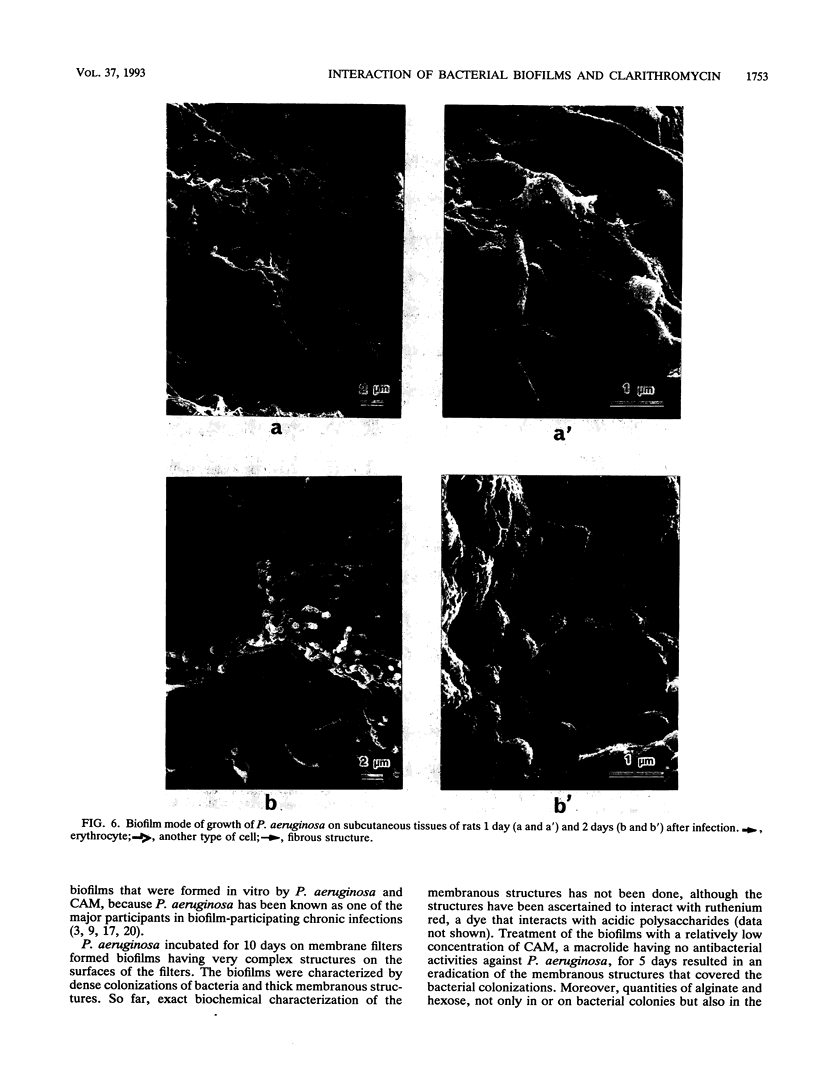
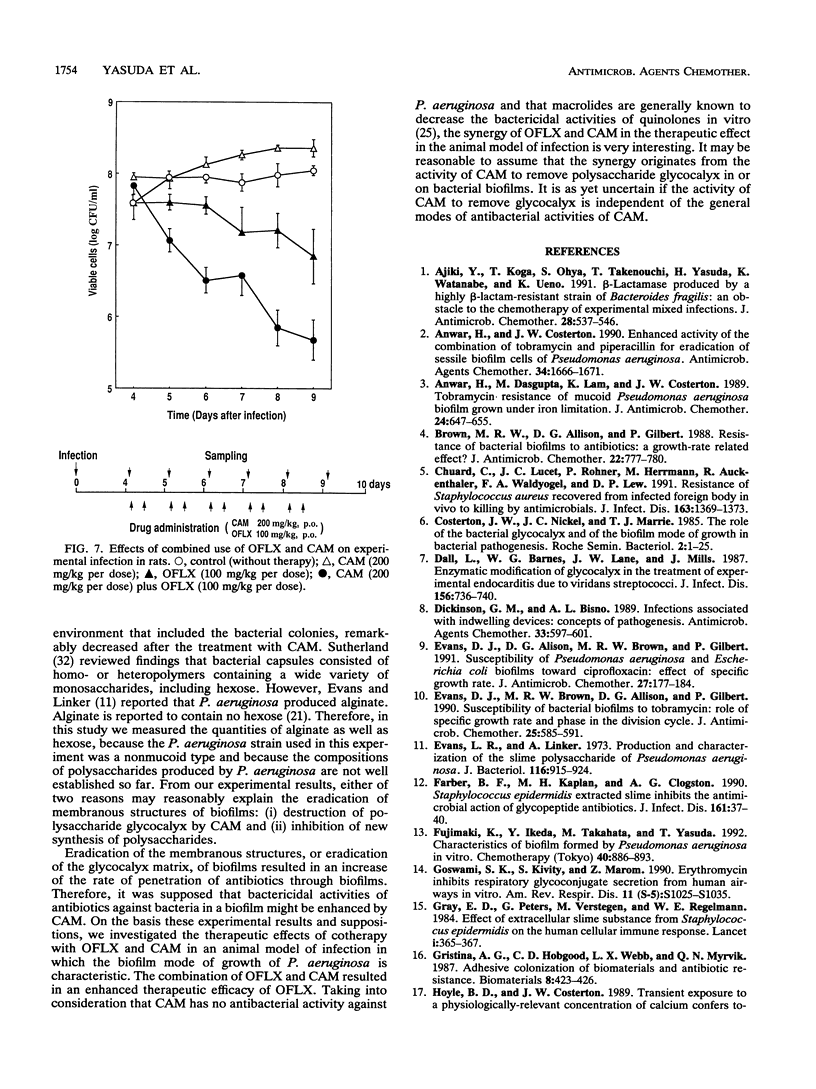
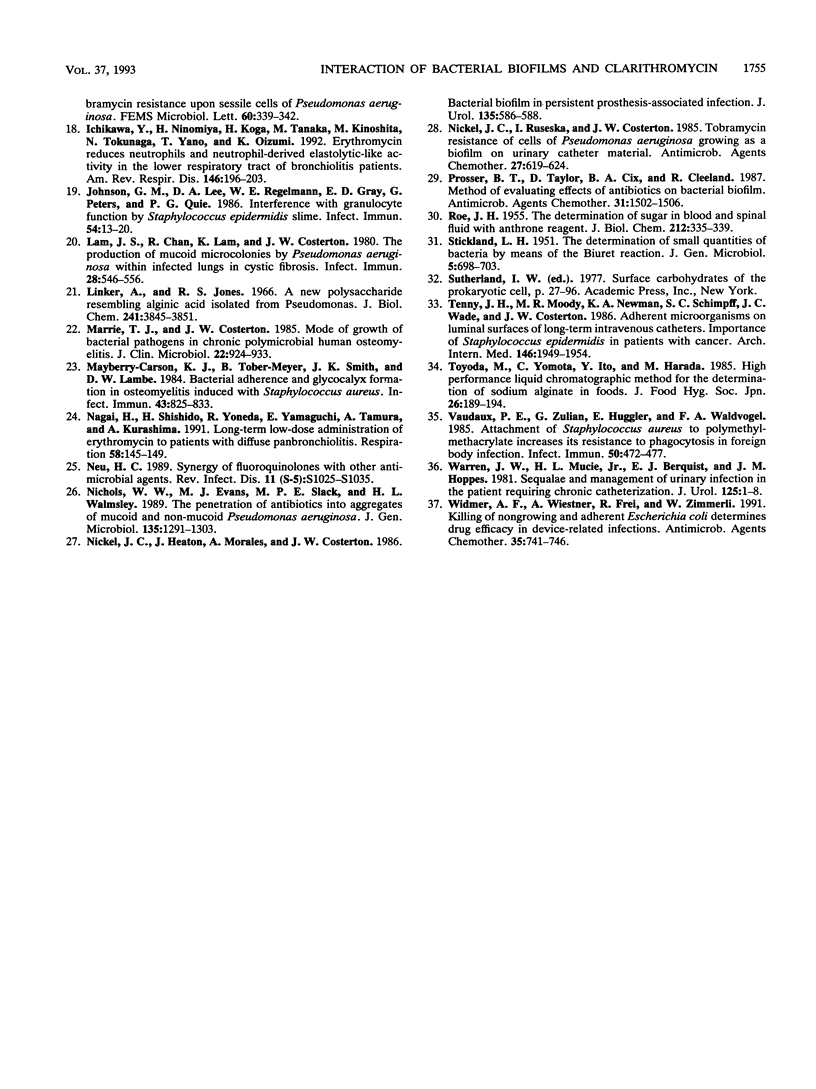
Images in this article
Selected References
These references are in PubMed. This may not be the complete list of references from this article.
- Ajiki Y., Koga T., Ohya S., Takenouchi T., Yasuda H., Watanabe K., Ueno K. beta-Lactamase produced by a highly beta-lactam-resistant strain of Bacteroides fragilis: an obstacle to the chemotherapy of experimental mixed infections. J Antimicrob Chemother. 1991 Oct;28(4):537–546. doi: 10.1093/jac/28.4.537. [DOI] [PubMed] [Google Scholar]
- Anwar H., Costerton J. W. Enhanced activity of combination of tobramycin and piperacillin for eradication of sessile biofilm cells of Pseudomonas aeruginosa. Antimicrob Agents Chemother. 1990 Sep;34(9):1666–1671. doi: 10.1128/aac.34.9.1666. [DOI] [PMC free article] [PubMed] [Google Scholar]
- Anwar H., Dasgupta M., Lam K., Costerton J. W. Tobramycin resistance of mucoid Pseudomonas aeruginosa biofilm grown under iron limitation. J Antimicrob Chemother. 1989 Nov;24(5):647–655. doi: 10.1093/jac/24.5.647. [DOI] [PubMed] [Google Scholar]
- Brown M. R., Allison D. G., Gilbert P. Resistance of bacterial biofilms to antibiotics: a growth-rate related effect? J Antimicrob Chemother. 1988 Dec;22(6):777–780. doi: 10.1093/jac/22.6.777. [DOI] [PubMed] [Google Scholar]
- Chuard C., Lucet J. C., Rohner P., Herrmann M., Auckenthaler R., Waldvogel F. A., Lew D. P. Resistance of Staphylococcus aureus recovered from infected foreign body in vivo to killing by antimicrobials. J Infect Dis. 1991 Jun;163(6):1369–1373. [PubMed] [Google Scholar]
- Dall L., Barnes W. G., Lane J. W., Mills J. Enzymatic modification of glycocalyx in the treatment of experimental endocarditis due to viridans streptococci. J Infect Dis. 1987 Nov;156(5):736–740. doi: 10.1093/infdis/156.5.736. [DOI] [PubMed] [Google Scholar]
- Dickinson G. M., Bisno A. L. Infections associated with indwelling devices: concepts of pathogenesis; infections associated with intravascular devices. Antimicrob Agents Chemother. 1989 May;33(5):597–601. doi: 10.1128/aac.33.5.597. [DOI] [PMC free article] [PubMed] [Google Scholar]
- Evans D. J., Allison D. G., Brown M. R., Gilbert P. Susceptibility of Pseudomonas aeruginosa and Escherichia coli biofilms towards ciprofloxacin: effect of specific growth rate. J Antimicrob Chemother. 1991 Feb;27(2):177–184. doi: 10.1093/jac/27.2.177. [DOI] [PubMed] [Google Scholar]
- Evans D. J., Brown M. R., Allison D. G., Gilbert P. Susceptibility of bacterial biofilms to tobramycin: role of specific growth rate and phase in the division cycle. J Antimicrob Chemother. 1990 Apr;25(4):585–591. doi: 10.1093/jac/25.4.585. [DOI] [PubMed] [Google Scholar]
- Evans L. R., Linker A. Production and characterization of the slime polysaccharide of Pseudomonas aeruginosa. J Bacteriol. 1973 Nov;116(2):915–924. doi: 10.1128/jb.116.2.915-924.1973. [DOI] [PMC free article] [PubMed] [Google Scholar]
- Farber B. F., Kaplan M. H., Clogston A. G. Staphylococcus epidermidis extracted slime inhibits the antimicrobial action of glycopeptide antibiotics. J Infect Dis. 1990 Jan;161(1):37–40. doi: 10.1093/infdis/161.1.37. [DOI] [PubMed] [Google Scholar]
- Gray E. D., Peters G., Verstegen M., Regelmann W. E. Effect of extracellular slime substance from Staphylococcus epidermidis on the human cellular immune response. Lancet. 1984 Feb 18;1(8373):365–367. doi: 10.1016/s0140-6736(84)90413-6. [DOI] [PubMed] [Google Scholar]
- Gristina A. G., Hobgood C. D., Webb L. X., Myrvik Q. N. Adhesive colonization of biomaterials and antibiotic resistance. Biomaterials. 1987 Nov;8(6):423–426. doi: 10.1016/0142-9612(87)90077-9. [DOI] [PubMed] [Google Scholar]
- Hoyle B. D., Costerton J. W. Transient exposure to a physiologically-relevant concentration of calcium confers tobramycin resistance upon sessile cells of Pseudomonas aeruginosa. FEMS Microbiol Lett. 1989 Aug;51(3):339–341. doi: 10.1016/0378-1097(89)90421-7. [DOI] [PubMed] [Google Scholar]
- Ichikawa Y., Ninomiya H., Koga H., Tanaka M., Kinoshita M., Tokunaga N., Yano T., Oizumi K. Erythromycin reduces neutrophils and neutrophil-derived elastolytic-like activity in the lower respiratory tract of bronchiolitis patients. Am Rev Respir Dis. 1992 Jul;146(1):196–203. doi: 10.1164/ajrccm/146.1.196. [DOI] [PubMed] [Google Scholar]
- Johnson G. M., Lee D. A., Regelmann W. E., Gray E. D., Peters G., Quie P. G. Interference with granulocyte function by Staphylococcus epidermidis slime. Infect Immun. 1986 Oct;54(1):13–20. doi: 10.1128/iai.54.1.13-20.1986. [DOI] [PMC free article] [PubMed] [Google Scholar]
- Lam J., Chan R., Lam K., Costerton J. W. Production of mucoid microcolonies by Pseudomonas aeruginosa within infected lungs in cystic fibrosis. Infect Immun. 1980 May;28(2):546–556. doi: 10.1128/iai.28.2.546-556.1980. [DOI] [PMC free article] [PubMed] [Google Scholar]
- Linker A., Jones R. S. A new polysaccharide resembling alginic acid isolated from pseudomonads. J Biol Chem. 1966 Aug 25;241(16):3845–3851. [PubMed] [Google Scholar]
- Marrie T. J., Costerton J. W. Mode of growth of bacterial pathogens in chronic polymicrobial human osteomyelitis. J Clin Microbiol. 1985 Dec;22(6):924–933. doi: 10.1128/jcm.22.6.924-933.1985. [DOI] [PMC free article] [PubMed] [Google Scholar]
- Mayberry-Carson K. J., Tober-Meyer B., Smith J. K., Lambe D. W., Jr, Costerton J. W. Bacterial adherence and glycocalyx formation in osteomyelitis experimentally induced with Staphylococcus aureus. Infect Immun. 1984 Mar;43(3):825–833. doi: 10.1128/iai.43.3.825-833.1984. [DOI] [PMC free article] [PubMed] [Google Scholar]
- Nagai H., Shishido H., Yoneda R., Yamaguchi E., Tamura A., Kurashima A. Long-term low-dose administration of erythromycin to patients with diffuse panbronchiolitis. Respiration. 1991;58(3-4):145–149. doi: 10.1159/000195915. [DOI] [PubMed] [Google Scholar]
- Neu H. C. Synergy of fluoroquinolones with other antimicrobial agents. Rev Infect Dis. 1989 Jul-Aug;11 (Suppl 5):S1025–S1035. doi: 10.1093/clinids/11.supplement_5.s1025. [DOI] [PubMed] [Google Scholar]
- Nichols W. W., Evans M. J., Slack M. P., Walmsley H. L. The penetration of antibiotics into aggregates of mucoid and non-mucoid Pseudomonas aeruginosa. J Gen Microbiol. 1989 May;135(5):1291–1303. doi: 10.1099/00221287-135-5-1291. [DOI] [PubMed] [Google Scholar]
- Nickel J. C., Heaton J., Morales A., Costerton J. W. Bacterial biofilm in persistent penile prosthesis-associated infection. J Urol. 1986 Mar;135(3):586–588. doi: 10.1016/s0022-5347(17)45747-8. [DOI] [PubMed] [Google Scholar]
- Nickel J. C., Ruseska I., Wright J. B., Costerton J. W. Tobramycin resistance of Pseudomonas aeruginosa cells growing as a biofilm on urinary catheter material. Antimicrob Agents Chemother. 1985 Apr;27(4):619–624. doi: 10.1128/aac.27.4.619. [DOI] [PMC free article] [PubMed] [Google Scholar]
- Prosser B. L., Taylor D., Dix B. A., Cleeland R. Method of evaluating effects of antibiotics on bacterial biofilm. Antimicrob Agents Chemother. 1987 Oct;31(10):1502–1506. doi: 10.1128/aac.31.10.1502. [DOI] [PMC free article] [PubMed] [Google Scholar]
- ROE J. H. The determination of sugar in blood and spinal fluid with anthrone reagent. J Biol Chem. 1955 Jan;212(1):335–343. [PubMed] [Google Scholar]
- STICKLAND L. H. The determination of small quantities of bacteria by means of the biuret reaction. J Gen Microbiol. 1951 Oct;5(4):698–703. doi: 10.1099/00221287-5-4-698. [DOI] [PubMed] [Google Scholar]
- Tenney J. H., Moody M. R., Newman K. A., Schimpff S. C., Wade J. C., Costerton J. W., Reed W. P. Adherent microorganisms on lumenal surfaces of long-term intravenous catheters. Importance of Staphylococcus epidermidis in patients with cancer. Arch Intern Med. 1986 Oct;146(10):1949–1954. [PubMed] [Google Scholar]
- Vaudaux P. E., Zulian G., Huggler E., Waldvogel F. A. Attachment of Staphylococcus aureus to polymethylmethacrylate increases its resistance to phagocytosis in foreign body infection. Infect Immun. 1985 Nov;50(2):472–477. doi: 10.1128/iai.50.2.472-477.1985. [DOI] [PMC free article] [PubMed] [Google Scholar]
- Warren J. W., Muncie H. L., Jr, Bergquist E. J., Hoopes J. M. Sequelae and management of urinary infection in the patient requiring chronic catheterization. J Urol. 1981 Jan;125(1):1–8. doi: 10.1016/s0022-5347(17)54874-0. [DOI] [PubMed] [Google Scholar]
- Widmer A. F., Wiestner A., Frei R., Zimmerli W. Killing of nongrowing and adherent Escherichia coli determines drug efficacy in device-related infections. Antimicrob Agents Chemother. 1991 Apr;35(4):741–746. doi: 10.1128/aac.35.4.741. [DOI] [PMC free article] [PubMed] [Google Scholar]



